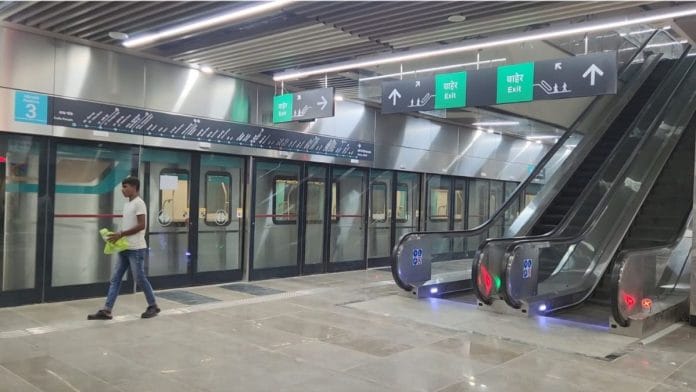Mumbai: Mumbai’s first fully-underground metro line, Metro Line 3, will be completely operational only by March to April next year, as work on a couple of stations is lagging behind, ThePrint has learnt.
However, the first phase of Metro Line 3 (Aqua Line), which will connect Bandra Kurla Complex and Aarey, will be open to the public by October this year.
According to the Mumbai Metro Rail Corporation (MMRC), the nodal agency for this metro project, work on some of the stations is complicated and ongoing.
“But even before that, we are planning to see if we can open the project up to Worli station. But here also, there are some stations that are challenging,” Ashwini Bhide, Managing Director, MMRC, told ThePrint.
“The Worli Naka station, where there are multiple entry and exit points, and utility wires, is challenging to construct. The Girgaon station is also challenging because the work started late due to the area being densely populated. So, it depends on these two stations on when work will start on the entire corridor,” she added.
The MMRC is pushing to complete all the remaining civil work by the end of the year, so that Metro Line 3 can be fully commissioned by March to April next year, Bhide said.
Though the first phase is expected to be open by the first week of October, the initiation date also depends on when Manoj Arora, Commissioner of Railway Safety (CRS) for the Central Circle in Mumbai, arrives for inspection to confirm the route’s safety.
The total cost of the project is Rs 37,275 crore, which is more than the initial budget of Rs 23,900 estimated in 2011.
“The cost escalation is due to delays in the projects, changes in some designs, and price realisation, which happened as we progressed,” Bhide said.
Also Read: 3 govts, 3 pivots: How farm loan waivers announced in Maharashtra fared over the years
All about first phase of Metro Line 3
The first phase of Metro Line 3 is painted in aqua. The train’s interior and exterior, station names, and indicators—all are aqua in colour.
It will run from 6.30 am to 10.30 pm, with nine trains completing 96 trips every day. On Sundays, the trains will start at 8.30 am. Of 48 train captains, 10 will be female.
Tickets are priced at Rs 10 to 50 for the first phase, and once the entire project is complete, the maximum price will be Rs 70.
The first phase, which is about 12.44 kilometres long, has a total of 10 stations. Of these, nine are underground. The tenth is a grade-level station (transit station on the ground) called Aarey metro station, which is located at the junction of the Jogeshwari-Vikhroli Link Road (JVLR) and Metro Line 3.
Some stations are so deep underground that the escalators are more than 10 metres high.
The first phase is also integrated with other lines.
One of the most important integrations is at Marol Naka, where a passenger will have to get out and take Line 1.
“The stations are close to one another, and passengers will not face any inconvenience,” Ramana Rachaprolu, director (planning), MMRC, told ThePrint.
How Mumbai will benefit from Metro Line 3
Metro Line 3 will also provide connectivity to both domestic and international airports.
“However, right now, MMRC and Mumbai India International Airport (MIAL) are working to provide pedestrian walkway facilities to and from the airport,” Bhide said.
She added: “Ultimate connectivity will happen only when the MIAL completes the construction work, which can take up to a year or two. But once that is complete, it will provide seamless connectivity to and from the airport from within the enclosure, without the need for one to come out.”
Till then, however, the authorities are working to provide connectivity by making pedestrian friendly walkways at different entry and exit points, Bhide said. This can even mean adding shuttles if need be.
“But this is only temporary. The connectivity will become seamless in future,” Bhide said.
According to MMRC officials, once the entire corridor is complete, only 15 percent of suburban traffic is expected to move to Metro Line 3 and the bulk will come from road traffic.
This will help decongest Mumbai’s road traffic, they expect. The time taken to commute between Aarey and Cuffe Parade in south Mumbai by metro is expected to be about an hour, compared to two to three hours when using the road.
Once the entire line is complete, the MMRC expects a daily ridership of 13 lakh passengers, ferrying approximately 2,500 passengers in each train.
There is a station at every kilometre, with frontal openings in the trains for emergencies, authorities say. There is also a provision to open all doors in such cases.
Since the station is going to be close by, people can use walkways along the tracks to reach the nearest station.
“So, one need not worry,” Bhide assured.
(Edited by Radifah Kabir)
Also Read: Backed by Mahayuti, shared stage with RSS chief—who is ‘seer’ Ramgiri Maharaj






